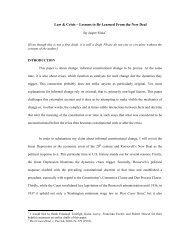updating brignoni-ponce - New York University School of Law
updating brignoni-ponce - New York University School of Law
updating brignoni-ponce - New York University School of Law
You also want an ePaper? Increase the reach of your titles
YUMPU automatically turns print PDFs into web optimized ePapers that Google loves.
2008] UPDATING BRIGNONI-PONCE 607<br />
entered legally, less than 500,000 were border crossing card violators.<br />
250 Since the public is interested in seeing immigration laws enforced<br />
despite undocumented immigrants’ mode <strong>of</strong> entry, these<br />
corrected statistics may not change the Fourth Amendment analysis.<br />
C. Individuals’ Right to Personal Security Free from Arbitrary<br />
Interference by <strong>Law</strong> Enforcement Officers<br />
The Court in Brignoni-Ponce described the intrusion <strong>of</strong> the investigatory<br />
immigration stop in people’s individual liberty as “modest.”<br />
251 The stop typically lasts for less than a minute, and <strong>of</strong>ficers<br />
can only inspect those parts <strong>of</strong> the vehicle that can be seen by anyone<br />
standing alongside the vehicle. 252 The Court did not consider whether<br />
the fact that the Border Patrol could consider race as a factor in making<br />
this decision would cause any additional harm. The Court has<br />
made Fourth Amendment balancing decisions in the past either by dismissing<br />
any <strong>of</strong> the indirect and stigmatic harm caused to the individual<br />
or to the public as insignificant or by not referring to such harm at<br />
all. 253 However, scholarship and advocacy organizations, as will be<br />
seen, have argued that the effect <strong>of</strong> these one-minute stops is actually<br />
quite significant. This section will consider the impact <strong>of</strong> race-based<br />
stops with regard to stigma, tension between the targeted community<br />
and law enforcement <strong>of</strong>ficers, and private discrimination.<br />
1. Stigmatic Harm<br />
Under Brignoni-Ponce, persons appearing to be <strong>of</strong> Latin American<br />
ancestry are more likely than other persons to be stopped and<br />
questioned about their immigration status. 254 Considering that only<br />
approximately 10% <strong>of</strong> Latinos are undocumented, this racial pr<strong>of</strong>iling<br />
has a high probability <strong>of</strong> error. 255 Injuries from dignitary harms can<br />
250. Id. at 1.<br />
251. Brignoni-Ponce, 422 U.S. at 879–80.<br />
252. Id. at 880.<br />
253. See United States v. Martinez-Fuerte, 428 U.S. 543, 560 (1976) (accusing defendants<br />
<strong>of</strong> overstating the stigma and consequences associated with a secondary referral<br />
at a standing checkpoint); Brignoni-Ponce, 422 U.S. 873, 880 (referring only to<br />
the minimal intrusion caused by a stop that lasts less than a minute); Terry v. Ohio,<br />
392 U.S. 1 (1968) (omitting any mention <strong>of</strong> defendants’ race and possible stigmatic<br />
harm).<br />
254. Johnson, Against Racial Pr<strong>of</strong>iling in Immigration Enforcement, supra note 108, R<br />
at 707.<br />
255. Johnson, Challenging Racial Pr<strong>of</strong>iling, supra note 29, at 345; Motomura, supra R<br />
note 230, at 415 (discussing Pr<strong>of</strong>essor Lund’s position that racial pr<strong>of</strong>iling is “<strong>of</strong>ten R<br />
inaccurate and irrational”); see Johnson, Against Racial Pr<strong>of</strong>iling in Immigration Enforcement,<br />
supra note 108, at 709. R
















